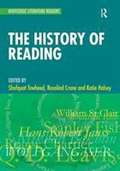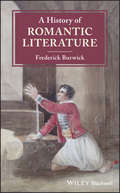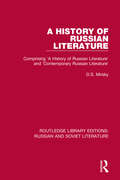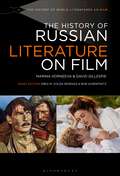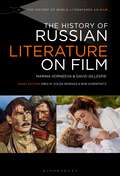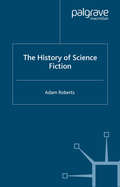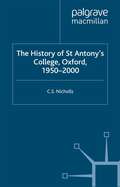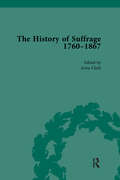- Table View
- List View
The History of Reading: International Perspectives, c. 1500-1990
by Shafquat Towheed and W. R. OwensBringing together research from a variety of countries and periods, this volume introduces readers to the diverse approaches used to recover the evidence of reading through history in different societies, and asks whether reading practices are always conditioned by specific local circumstances or whether broader patterns might emerge.
The History of Reading: A Reader (PDF)
by Shafquat Towheed Rosalind Crone Katherine HalseyThe History of Reading offers an engaging, accessible overview from the rise of literacy through to the current trend of ‘book clubs’. Divided into seven sections, each with a useful introduction, this Reader: summarises the main debates and perspectives shaping the field introduces key theorists such as Iser, Fish and Bakhtin surveys influential works and outlines important studies on mass reading focuses on specific communities such as Welsh miners, African American library users and Australian convicts looks at individual readers from a variety of countries, classes and historical periods considers current research in the history of reading. Providing both a clear introduction to the history of the field and a taster of the breadth, diversity and vitality of current debates, this Reader is an essential resource for undergraduates, graduates, and researchers.
The History of Reading, Volume 2: Evidence from the British Isles, c.1750-1950
by Katie Halsey, W.R. Owens'Reading has a history. But how can we recover it?' This volume brings together original research essays focusing on the history of reading in the British Isles, using evidence ranging from library records to Mass Observation surveys to highlight the social factors that influence a seemingly private, individual activity.
The History of Reading, Volume 3: Methods, Strategies, Tactics
by Rosalind Crone, Shafquat Towheed, and Simon EliotWe inhabit a textually super-saturated and increasingly literate world. This volume encourages readers to consider the diverse methodologies used by historians of reading globally, and indicates how future research might take up the challenge of recording and interpreting the practices of readers in an increasingly digitized society.
A History of Rhetoric, Sound, and Health and Healing (Routledge Studies in Rhetoric and Communication)
by Kristin Marie BivensA History of Rhetoric, Sound, and Health and Healing argues for medico-sonic knowledge — systematically interpreted bodily sounds with medical knowledge mediated by rhetoric — as an evolving corporeal practice with an incomparable, sprawling history.Taking a materialist-feminist perspective, the book rhetorically accounts for sound and suggests rhetoric enables bodily sounds as understandable, knowable, and treatable with power to help and discipline bodies in health, healing, and hospital contexts. From an expansive, pan-historiographic approach integrated with and influenced by fieldwork from neonatal intensive care units (NICUs) in Denmark and the United States, the author explores intentional and unintentional diagnostic, prognostic, and therapeutic uses of sound in contemporary Western biomedical health systems and promotes a new research concept and fieldwork practice, sound in all research.The insightful, timely volume will interest students and researchers in the medical humanities, rhetoric and communication, health communication, sound studies, medical and allied health sciences, and research methods.
A History of Rhetoric, Sound, and Health and Healing (Routledge Studies in Rhetoric and Communication)
by Kristin Marie BivensA History of Rhetoric, Sound, and Health and Healing argues for medico-sonic knowledge — systematically interpreted bodily sounds with medical knowledge mediated by rhetoric — as an evolving corporeal practice with an incomparable, sprawling history.Taking a materialist-feminist perspective, the book rhetorically accounts for sound and suggests rhetoric enables bodily sounds as understandable, knowable, and treatable with power to help and discipline bodies in health, healing, and hospital contexts. From an expansive, pan-historiographic approach integrated with and influenced by fieldwork from neonatal intensive care units (NICUs) in Denmark and the United States, the author explores intentional and unintentional diagnostic, prognostic, and therapeutic uses of sound in contemporary Western biomedical health systems and promotes a new research concept and fieldwork practice, sound in all research.The insightful, timely volume will interest students and researchers in the medical humanities, rhetoric and communication, health communication, sound studies, medical and allied health sciences, and research methods.
History of Rhetoric, Volume I: The Art of Persuasion in Greece
by George A. KennedyA concern for the art of persuasion, as rhetoric was anciently defined, was a principal feature of Greek intellectual life. In this study of the complex of subjects labeled "rhetoric," the author explores rhetorical theory and practice from the fifth to the first centuries B.C. Beginning with the creative rhetoric of the pre-Socratic era, the study progresses through the time of Aristotle and the Attic orators and concludes with the ossification of rhetoric into a pedantic discipline during the Hellenistic period.Originally published in 1963.The Princeton Legacy Library uses the latest print-on-demand technology to again make available previously out-of-print books from the distinguished backlist of Princeton University Press. These editions preserve the original texts of these important books while presenting them in durable paperback and hardcover editions. The goal of the Princeton Legacy Library is to vastly increase access to the rich scholarly heritage found in the thousands of books published by Princeton University Press since its founding in 1905.
A History of Roman Art
by Steven L. TuckA History of Roman Art provides a wide-ranging survey of the subject from the founding of Rome to the rule of Rome's first Christian emperor, Constantine. Incorporating the most up-to-date information available on the topic, this new textbook explores the creation, use, and meaning of art in the Roman world. Extensively illustrated with 375 color photographs and line drawings Broadly defines Roman art to include the various cultures that contributed to the Roman system Focuses throughout on the overarching themes of Rome's cultural inclusiveness and art's important role in promoting Roman values Discusses a wide range of Roman painting, mosaic, sculpture, and decorative arts, as well as architecture and associated sculptures within the cultural contexts they were created and developed Offers helpful and instructive pedagogical features for students, such as timelines; key terms defined in margins; a glossary; sidebars with key lessons and explanatory material on artistic technique, stories, and ancient authors; textboxes on art and literature, art from the provinces, and important scholarly perspectives; and primary sources in translation A book companion website is available at www.wiley.com/go/romanart with the following resources: PowerPoint slides, glossary, and timeline Steven Tuck is the 2014 recipient of the American Archaeological Association's Excellence in Undergraduate Teaching Award.
A History of Roman Art
by Steven L. TuckA History of Roman Art provides a wide-ranging survey of the subject from the founding of Rome to the rule of Rome's first Christian emperor, Constantine. Incorporating the most up-to-date information available on the topic, this new textbook explores the creation, use, and meaning of art in the Roman world. Extensively illustrated with 375 color photographs and line drawings Broadly defines Roman art to include the various cultures that contributed to the Roman system Focuses throughout on the overarching themes of Rome's cultural inclusiveness and art's important role in promoting Roman values Discusses a wide range of Roman painting, mosaic, sculpture, and decorative arts, as well as architecture and associated sculptures within the cultural contexts they were created and developed Offers helpful and instructive pedagogical features for students, such as timelines; key terms defined in margins; a glossary; sidebars with key lessons and explanatory material on artistic technique, stories, and ancient authors; textboxes on art and literature, art from the provinces, and important scholarly perspectives; and primary sources in translation A book companion website is available at www.wiley.com/go/romanart with the following resources: PowerPoint slides, glossary, and timeline Steven Tuck is the 2014 recipient of the American Archaeological Association's Excellence in Undergraduate Teaching Award.
A History of Roman Art
by Steven L. TuckThe new edition of the leading textbook on Roman art, updated with new images and expanded geographic and cultural scope A History of Roman Art is an expansive survey of the painting, mosaic, sculpture, decorative arts, and architecture of ancient Rome. This acclaimed textbook provides a fully-illustrated narrative history of Roman art that spans a millennium, from the early origins of Rome to the era of Emperor Constantine. Interwoven throughout the text are themes of Rome's cultural inclusiveness and the importance of art in promoting Roman values, helping students understand how diverse cultures contributed to Roman life. Accessible, chronologically-organized chapters provide numerous examples of the arts, their cultural and historical context, descriptions of artistic techniques, and writings by ancient authors—enabling students to develop a rich appreciation of art’s importance in the Roman world. Now in its second edition, this market-leading textbook features thoroughly revised content throughout. Additional images and excerpts from literary sources are complemented by new historical discussions of metalwork, carved gems, glass, and sarcophagi. This edition features more maps and illustrations, in-depth analysis of iconography, greater emphasis on the types of objects used to decorate the lives of ordinary Romans, expanded coverage of freedmen and women as artists, subjects, and patrons, and much more. A number of works that represent popular art have been added. That is, art in the everyday Roman world, rather than just the large scale works of sculpture and architecture of elite patrons. It also reveals patterns of artistic workshops, trade, and social and economic networks. Additionally, this edition takes into account new approaches in scholarship. This comprehensive textbook: Provides a thorough introduction to Roman art history featuring more than 400 high quality images and illustrations Includes a full set of pedagogical tools, such as historical timelines, key term definitions, and updated references and further reading suggestions Offers “Scholarly Perspective,” “A View from the Provinces,” “More on Myth,” and “Art and Literature” textboxes in each chapter Includes a companion website containing PowerPoint slides and additional instructor resources A History of Roman Art, Second Edition is an ideal primary o
A History of Roman Art
by Steven L. TuckThe new edition of the leading textbook on Roman art, updated with new images and expanded geographic and cultural scope A History of Roman Art is an expansive survey of the painting, mosaic, sculpture, decorative arts, and architecture of ancient Rome. This acclaimed textbook provides a fully-illustrated narrative history of Roman art that spans a millennium, from the early origins of Rome to the era of Emperor Constantine. Interwoven throughout the text are themes of Rome's cultural inclusiveness and the importance of art in promoting Roman values, helping students understand how diverse cultures contributed to Roman life. Accessible, chronologically-organized chapters provide numerous examples of the arts, their cultural and historical context, descriptions of artistic techniques, and writings by ancient authors—enabling students to develop a rich appreciation of art’s importance in the Roman world. Now in its second edition, this market-leading textbook features thoroughly revised content throughout. Additional images and excerpts from literary sources are complemented by new historical discussions of metalwork, carved gems, glass, and sarcophagi. This edition features more maps and illustrations, in-depth analysis of iconography, greater emphasis on the types of objects used to decorate the lives of ordinary Romans, expanded coverage of freedmen and women as artists, subjects, and patrons, and much more. A number of works that represent popular art have been added. That is, art in the everyday Roman world, rather than just the large scale works of sculpture and architecture of elite patrons. It also reveals patterns of artistic workshops, trade, and social and economic networks. Additionally, this edition takes into account new approaches in scholarship. This comprehensive textbook: Provides a thorough introduction to Roman art history featuring more than 400 high quality images and illustrations Includes a full set of pedagogical tools, such as historical timelines, key term definitions, and updated references and further reading suggestions Offers “Scholarly Perspective,” “A View from the Provinces,” “More on Myth,” and “Art and Literature” textboxes in each chapter Includes a companion website containing PowerPoint slides and additional instructor resources A History of Roman Art, Second Edition is an ideal primary o
A History of Romantic Literature (Blackwell History of Literature)
by Frederick BurwickHistorical Narrative Offers Introduction to Romanticism by Placing Key Figures in Overall Social Context Going beyond the general literary survey, A History of Romantic Literature examines the literatures of sensibility and intensity as well as the aesthetic dimensions of horror and terror, sublimity and ecstasy, by providing a richly integrated account of shared themes, interests, innovations, rivalries and disputes among the writers of the late eighteenth and early nineteenth centuries. Drawing from the assemblage theory, Prof. Burwick maintains that the literature of the period is inseparable from prevailing economic conditions and ongoing political and religious turmoil, as well as developments in physics, astronomy, music and art. Thus, rather than deal with authors as if they worked in isolation from society, he identifies and describes their interactions with their communities and with one another, as well as their responses to current events. By connecting seemingly scattered and random events such as the bank crisis of 1825, he weaves the coincidental into a coherent narrative of the networking that informed the rise and progress of Romanticism. Notable features of the book include: A strong narrative structure divided into four major chronological periods: Revolution, 1789-1798; Napoleonic Wars, 1799-1815; Riots, 1815-1820; Reform, 1821-1832 Thorough coverage of major and minor figures and institutions of the Romantic movement (including Mary Wollstonecraft, Elizabeth Montague and the Bluestockings, Lord Byron, John Keats, Letitia Elizabeth Landon etc.) Emphasis on the influence of social networks among authors, such as informal dinners and teas, clubs, salons and more formal institutions With its extensive coverage and insightful analysis set within a lively historical narrative, History of Romantic Literature is highly recommended for courses on British Romanticism at both undergraduate and post-graduate levels. It will also prove a highly useful reference for advanced scholars pursuing their own research.
A History of Russian Literature
by Andrew Kahn Mark Lipovetsky Irina Reyfman Stephanie SandlerRussia possesses one of the richest and most admired literatures of Europe, reaching back to the eleventh century. A History of Russian Literature provides a comprehensive account of Russian writing from its earliest origins in the monastic works of Kiev up to the present day, still rife with the creative experiments of post-Soviet literary life. The volume proceeds chronologically in five parts, extending from Kievan Rus' in the 11th century to the present day. The coverage strikes a balance between extensive overview and in-depth thematic focus. Parts are organized thematically in chapters, which a number of keywords that are important literary concepts that can serve as connecting motifs and 'case studies', in-depth discussions of writers, institutions, and texts that take the reader up close and personal. Visual material also underscores the interrelation of the word and image at a number of points, particularly significant in the medieval period and twentieth century. The History addresses major continuities and discontinuities in the history of Russian literature across all periods, and in particular brings out trans-historical features that contribute to the notion of a national literature. The volume's time range has the merit of identifying from the early modern period a vital set of national stereotypes and popular folklore about boundaries, space, Holy Russia, and the charismatic king that offers culturally relevant material to later writers. This volume delivers a fresh view on a series of key questions about Russia's literary history, by providing new mappings of literary history and a narrative that pursues key concepts (rather more than individual authorial careers). This holistic narrative underscores the ways in which context and text are densely woven in Russian literature, and demonstrates that the most exciting way to understand the canon and the development of tradition is through a discussion of the interrelation of major and minor figures, historical events and literary politics, literary theory and literary innovation.
A History of Russian Literature
by Andrew Kahn Mark Lipovetsky Irina Reyfman Stephanie SandlerRussia possesses one of the richest and most admired literatures of Europe, reaching back to the eleventh century. A History of Russian Literature provides a comprehensive account of Russian writing from its earliest origins in the monastic works of Kiev up to the present day, still rife with the creative experiments of post-Soviet literary life. The volume proceeds chronologically in five parts, extending from Kievan Rus' in the 11th century to the present day. The coverage strikes a balance between extensive overview and in-depth thematic focus. Parts are organized thematically in chapters, which a number of keywords that are important literary concepts that can serve as connecting motifs and 'case studies', in-depth discussions of writers, institutions, and texts that take the reader up close and personal. Visual material also underscores the interrelation of the word and image at a number of points, particularly significant in the medieval period and twentieth century. The History addresses major continuities and discontinuities in the history of Russian literature across all periods, and in particular brings out trans-historical features that contribute to the notion of a national literature. The volume's time range has the merit of identifying from the early modern period a vital set of national stereotypes and popular folklore about boundaries, space, Holy Russia, and the charismatic king that offers culturally relevant material to later writers. This volume delivers a fresh view on a series of key questions about Russia's literary history, by providing new mappings of literary history and a narrative that pursues key concepts (rather more than individual authorial careers). This holistic narrative underscores the ways in which context and text are densely woven in Russian literature, and demonstrates that the most exciting way to understand the canon and the development of tradition is through a discussion of the interrelation of major and minor figures, historical events and literary politics, literary theory and literary innovation.
A History of Russian Literature: Comprising 'A History of Russian Literature' and 'Contemporary Russian Literature' (Routledge Library Editions: Russian and Soviet Literature #6)
by D.S. MirskyThis book, first published in 1949, is an abridged version of Mirsky’s classic two texts on Russian literature, updated with a postscript by the editor assessing the development of Soviet literature. Beautifully written, Mirsky’s analyses of Russian writers and literature go hand in hand with his takes on Russian history. From the birth of Russian literature to its Soviet form, this book is a lively and comprehensive examination by one of its leading scholars.
A History of Russian Literature: Comprising 'A History of Russian Literature' and 'Contemporary Russian Literature' (Routledge Library Editions: Russian and Soviet Literature #6)
by D.S. MirskyThis book, first published in 1949, is an abridged version of Mirsky’s classic two texts on Russian literature, updated with a postscript by the editor assessing the development of Soviet literature. Beautifully written, Mirsky’s analyses of Russian writers and literature go hand in hand with his takes on Russian history. From the birth of Russian literature to its Soviet form, this book is a lively and comprehensive examination by one of its leading scholars.
The History of Russian Literature on Film (The History of World Literatures on Film)
by Marina Korneeva David GillespieUnlike most previous studies of literature and film, which tend to privilege particular authors, texts, or literary periods, David Gillespie and Marina Korneeva consider the multiple functions of filmed Russian literature as a cinematic subject in its own right-one reflecting the specific political and aesthetic priorities of different national and historical cinemas. In this first and only comprehensive study of cinema's various engagements of Russian literature focusing on the large period 1895-2015, The History of Russian Literature on Film highlights the ways these adaptations emerged from and continue to shape the social, artistic, and commercial aspects of film history.
The History of Russian Literature on Film (The History of World Literatures on Film)
by Marina Korneeva David GillespieUnlike most previous studies of literature and film, which tend to privilege particular authors, texts, or literary periods, David Gillespie and Marina Korneeva consider the multiple functions of filmed Russian literature as a cinematic subject in its own right-one reflecting the specific political and aesthetic priorities of different national and historical cinemas. In this first and only comprehensive study of cinema's various engagements of Russian literature focusing on the large period 1895-2015, The History of Russian Literature on Film highlights the ways these adaptations emerged from and continue to shape the social, artistic, and commercial aspects of film history.
The History of Science Fiction (Palgrave Histories of Literature)
by A. RobertsThe History of Science Fiction traces the origin and development of science fiction from Ancient Greece up to the present day. The author is both an academic literary critic and acclaimed creative writer of the genre. Written in lively, accessible prose it is specifically designed to bridge the worlds of academic criticism and SF fandom.
The History of Science Fiction (Palgrave Histories of Literature)
by Adam RobertsThis book is the definitive critical history of science fiction. The 2006 first edition of this work traced the development of the genre from Ancient Greece and the European Reformation through to the end of the 20th century. This new 2nd edition has been revised thoroughly and very significantly expanded. An all-new final chapter discusses 21st-century science fiction, and there is new material in every chapter: a wealth of new readings and original research. The author’s groundbreaking thesis that science fiction is born out of the 17th-century Reformation is here bolstered with a wide range of new supporting material and many hundreds of 17th- and 18th-century science fiction texts, some of which have never been discussed before. The account of 19th-century science fiction has been expanded, and the various chapters tracing the twentieth-century bring in more writing by women, and science fiction in other media including cinema, TV, comics, fan-culture and other modes.
A History of Seventeenth-Century English Literature (Blackwell History of Literature #1)
by Thomas N. CornsA History of Seventeenth-Century Literature outlines significant developments in the English literary tradition between the years 1603 and 1690. An energetic and provocative history of English literature from 1603-1690. Part of the major Blackwell History of English Literature series. Locates seventeenth-century English literature in its social and cultural contexts. Considers the physical conditions of literary production and consumption. Looks at the complex political, religious, cultural and social pressures on seventeenth-century writers. Features close critical engagement with major authors and texts Thomas Corns is a major international authority on Milton, the Caroline Court, and the political literature of the English Civil War and the Interregnum.
A History of Seventeenth-Century English Literature (Blackwell History of Literature)
by Thomas N. CornsA History of Seventeenth-Century Literature outlines significant developments in the English literary tradition between the years 1603 and 1690. An energetic and provocative history of English literature from 1603-1690. Part of the major Blackwell History of English Literature series. Locates seventeenth-century English literature in its social and cultural contexts. Considers the physical conditions of literary production and consumption. Looks at the complex political, religious, cultural and social pressures on seventeenth-century writers. Features close critical engagement with major authors and texts Thomas Corns is a major international authority on Milton, the Caroline Court, and the political literature of the English Civil War and the Interregnum.
The History of St Antony’s College, Oxford, 1950–2000 (St Antony's Series)
by C. NichollsSt Antony's College, Oxford, was founded by Antonin Besse and opened its doors in October 1950. Under the inspired leadership of William Deakin, the College became a centre for postgraduate teaching and research in the social sciences. The most deliberately international of all Oxford colleges, it was also the first to admit substantial numbers of women. This book recounts the College's history and describes the changing lifestyle of its students over the last fifty years.
The History of Suffrage, 1760-1867 Vol 6
by Anna Clark Sarah RichardsonThis work brings together key texts drawn from the history of suffrage advocacy and agitation. The whole issue of voting rights and representation is shown to be anchored firmly in the wider political culture of Britain and Ireland as well as the Empire as a whole. Volume 6 covers texts from 1860 to 1873.
The History of Suffrage, 1760-1867 Vol 6
by Anna Clark Sarah RichardsonThis work brings together key texts drawn from the history of suffrage advocacy and agitation. The whole issue of voting rights and representation is shown to be anchored firmly in the wider political culture of Britain and Ireland as well as the Empire as a whole. Volume 6 covers texts from 1860 to 1873.

